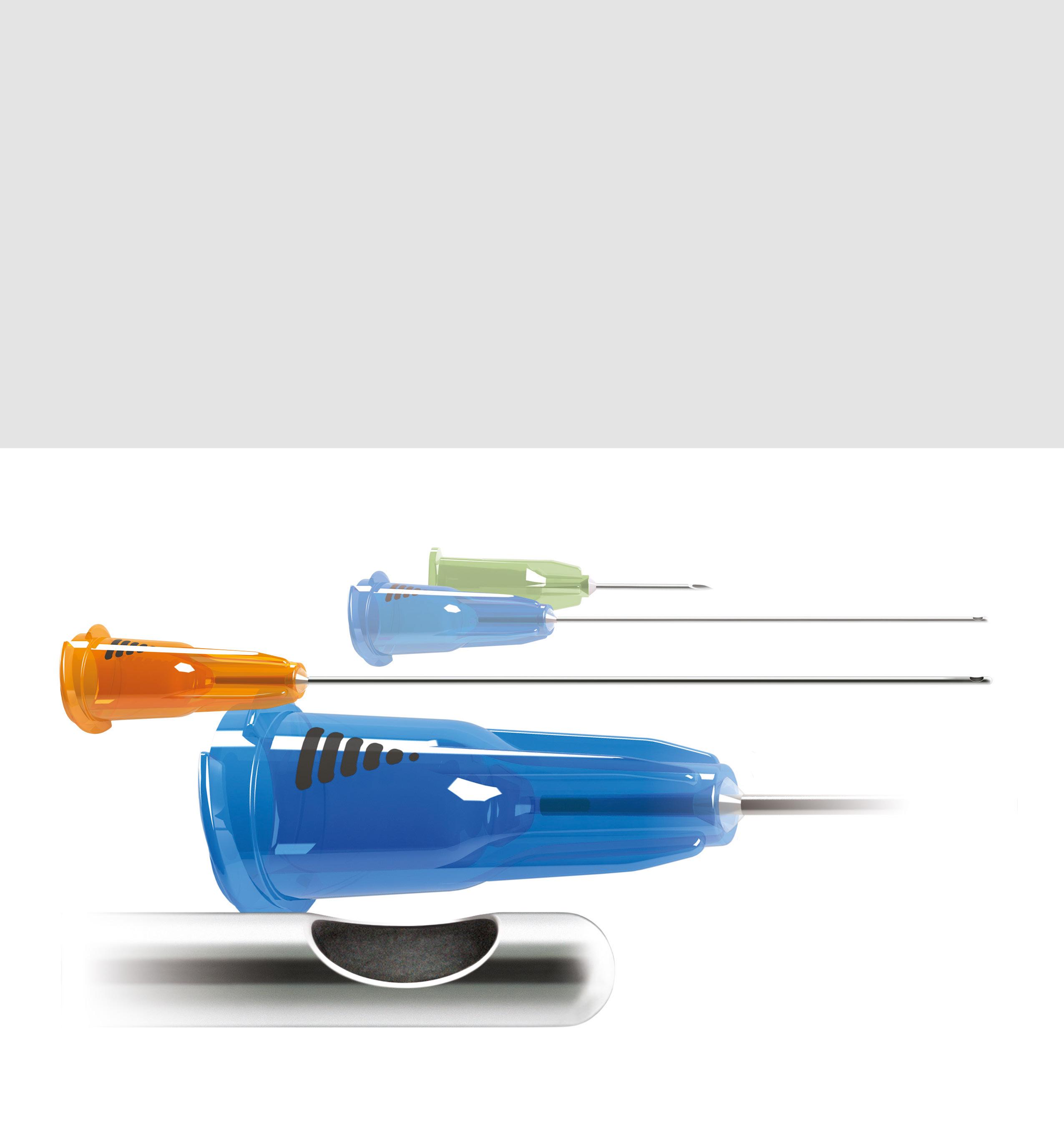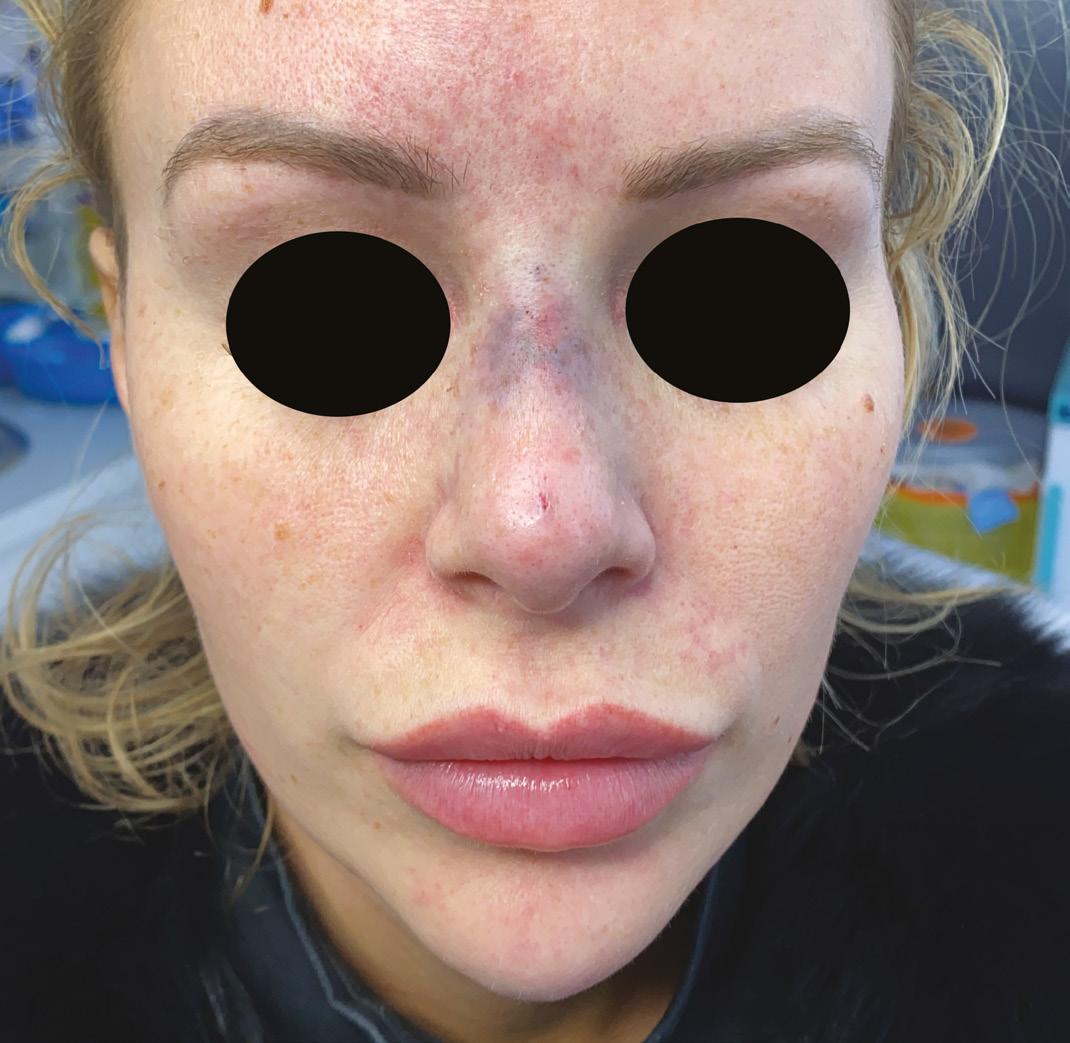
11 minute read
Exploring Hyperpigmentation in Skin of Colour
Exploring The process of melanin production The process of melanin production is regulated by the enzyme tyrosinase. This enzyme converts L-tyrosine Hyperpigmentation L-3,4-dihydroxyphenylalanine (L-DOPA), which is then oxidised to form L-dopauinone. This key compound can then follow two different pathways in Skin of Colour depending on the availability of cysteine to form eumelanin or pheomelanin (Figure 1).6 ,7 Melanocytes are cells within the basal layer of the epidermis responsible for producing melanin. Once Dr Manika Rajput discusses common causes formed, melanin is then packaged into small, round and management of hyperpigmentation in organelles called melanosomes which are transported to neighbouring keratinocytes via dendritic processes. patients with skin of colour They are deposited superficially to the cell nucleus to offer protection from UV radiation (Figure 1).8 Hyperpigmentation is defined as darkening patches of skin. This When this process goes into overdrive, excess melanin is produced occurs when the skin produces more melanin; the pigment that and can cause darkening of the skin in that area. This is known as gives skin its colour. Although hyperpigmentation occurs in all skin hyperpigmentation and occurs in various forms, which happen all types, it is one of the main skin complaints of people with darker over the body in small patches, spots or larger areas. There are many skin tones. Facial hyperpigmentation can cause significant cosmetic reasons why this happens, which are discussed next. disfigurement with subsequent emotional impact.1,2,3 Darker skin types are generally classified as Fitzpatrick types IV-VI. Sun damage There are structural and functional differences in the skin, which This is the main cause of hyperpigmentation and can exacerbate produces variances in skin conditions, presentation and treatments. existing hyperpigmentation. The initial melanin production from sun These skin types are categorised by higher melanin content and exposure acts as a natural sunscreen to protect from harmful UV more effective distribution of melanin, producing better protection rays. However, excess UVA and UVB exposure disrupts the melanin against ultraviolet (UV) radiation. Melanin is generally classified into production, which leads to increased pigmentation.This pigmentation two types: eumelanin and pheomelanin. Darker skin types have can be harder to treat as it is produced in the dermal layers of the a higher eumelanin to pheomelanin ratio, and higher amount of skin. In fact, this result can happen from any UVA and UVB source, eumelanin than lighter-skinned individuals.4 including sunbeds.5 Sun damage induced hyperpigmentation can present in multiple ways. Most commonly as ‘sunspots’, also known as The concentration of melanin in melanosomes within the epidermis ephelides and lentigines which presents as tan-dark brown macules is double in those with darker skin compared to lighter-pigmented or patches. Another presentation is melasma, which has multiple individuals, although the number of melanocytes is the same. There causes, one of which is intense sun exposure. This is visible as is also a slower degradation of the melanosome within a keratinocyte symmetrical light to dark brown patches with irregular borders and is in individuals with darker skin. These structural and functional most commonly seen on centrofacial, malar and mandibular regions. differences mean special considerations need to be given when Many of our mature skin-of-colour patients will experience darkening diagnosing and treating skin of colour.5 of malar cheeks and the forehead which is diagnosed as maturational dyschromia and has developed from years of chronic sun exposure. A rare presentation of sun L-Tyrosine Stage I Stage II (Finrillar Stage III Stage IV induced hyperpigmentation
Tyrosinase (TYR) matrix + TYR) (TYR + Melanin) (Melanin) is Lichen planus pigmentosus 3,4-dihydroxyphenylananine (L-DOPA) which favours Fitzpatrick lll-V
Advertisement
Tyrosinase (TYR) L-DOPAquinone Melanocyte skin types. It presents on sun-exposed areas as grey-
Glutathion or Cystein Leucodopachrome brown to brown macules and its distribution indicates UV
GlutathionylDOPA/ Cysteinyl DOPA DOPAchrome radiation as the cause.5 Hormones It has been shown in a number of studies from across the world that increased levels of oestrogen constitute a risk factor for hyperpigmentation disorders.9 This change in oestrogen levels is commonly seen in pregnancy. When hyperpigmentation presents in this way it is known as the
1,4Benzothiazinylalanine
PHEOMELANIN
Tyrosinase Related Protein 2 (TRP-2)
5,6dihydroxyindole -2-carboxylic acid (DHIGA)
Tyrosinase Related Protein 1 (TRP-1)
Indole-5-6-quinone -2-carboxylic acid 5,6dihydroxyindole (DHI)
Tyrosinase (TYR)
Indole-5-6quinone
EUMELANIN Golgi Body
Tyrosinase Synthesis
Rough Endoplasmic Reticulum (RER) Nucleus







mask of pregnancy – a form of melasma. As mentioned above melasma has multiple causes. Fortunately, in most cases it resolves or fades itself after pregnancy, however it can reappear with exposure to UV rays.5 These hyperpigmentation changes can also be seen with hormone replacement therapy (HRT) and combined oral contraceptive pills. Due to the decrease of oestrogen in menopause, it has been shown to improve symptoms of melasma when not taking HRT.9
Skin injuries and inflammation This is the main cause for post-inflammatory hyperpigmentation (PIH).10 Injuries such as cuts, burns, chemical exposure, infections or inflammation can lead to darkened patchy skin. Incorrect skin treatments which lead to damage and inflammation can also cause PIH. The long-term application and misuse of skin-lightening agents containing hydroquinone can lead to the formation of a blue-black pigmentation known as exogenous ochronosis. It is therefore important that prescription topical formulations of hydroquinone are used under clinician supervision.5 Allergens in cosmetics or textiles can induce pigmentated contact dermatitis also known as Riehl’s melanosis, which is characterised by a brown-grey appearance on areas of application.5
Genetics Hyperpigmentation can also be a hereditary condition seen more commonly in darker-skinned patients. This typically presents itself as a brown-black pigmented area around the eyes, known as periorbital hyperpigmentation.5
Illnesses and medication Systemic conditions such as Addison’s disease and hyperthyroidism cause a diffuse hyperpigmentation. It tends to be more pronounced in areas of sun exposure. Hemochromatosis, a disorder of iron storage and deposition, causes a slate-grey hyperpigmentation.11 Acanthosis nigricans typically affects Fitzpatrick Vl skin types and presents as thickened, hyperpigmented plaques. This is commonly associated with insulin resistance, obesity and polycystic ovary syndrome.5 A range of medications from chemotherapy drugs to antimalarials and anti-epileptic medication can also cause grey patches of pigmentation.12
Prevention Educating and advising patients about sun protection is key in preventing hyperpigmentation in the first place. It is important patients understand that sun protection needs to be used 365 days a year and that the sun will cause damage even on cloudy days.12 A broad-spectrum SPF 30+ needs to be used daily to give adequate protection from UVA and UVB rays.13 Many sunscreens now come in tinted formulations to help camouflage pigmentation too.5
To help prevent hyperpigmentation, patients should:5,14
• Avoid peak hours of sunlight between 11am to 3pm when the sun’s
UV rays are at their strongest • Seek shade and wear protective clothing such as sun hats and sunglasses • Use sun protection daily • Avoid picking or scratching spots or scabs • Avoid products or treatments that will cause irritation and inflammation of the skin It is important when limiting sun exposure to note that vitamin D synthesis is very important for bone health. Darker-skinned patients tend to have lower levels of vitamin D especially if they live in less sunny climates or are strict about sun exposure.5 These patients will need counselling and monitoring for vitamin D supplementation, however the Scientific Advisory Committee on Nutrition (SACN) recommends everyone over the age of four of any skin colour should consider taking a daily supplement all year round.15,16 When it comes to treating pigmentation, it is important to first identify and eliminate the cause. A tailored skincare regime can then be developed which suits the patient’s skin type and condition. This can help reduce the appearance of pigmentation and also prevent it from forming. It is important to note here that treatment of hyperpigmentation can be a difficult and prolonged process. There have been better results seen with epidermal pigmentation compared to dermal pigmentation and the patient needs to be informed and have their expectations managed.
Topical treatments
Hydroquinone This is considered the gold standard and most effective topical agent for treatment of pigmentation. Its mechanism of action is to inhibit tyrosinase and, in turn, the conversion of L-DOPA to melanin.13 Hydroquinone should be used with caution and for limited periods of time because if misused or used excessively it can lead to erythema, irritation, confetti-like depigmentation with higher concentrations, and exogenous ochronosis.5
Retinoids These are a form of vitamin A. Common preparations are retinoic acid, tretinoin, adapalene and tazarotene. They work to reduce hyperpigmentation through multiple mechanisms: increasing cell turnover, reducing melanin transfer via melanosomes, and allowing increased penetration of other active ingredients.
Ascorbic acid Ascorbic acid, also known as vitamin C, decreases melanin production by interacting with copper ions at the tyrosinase-active site, which inhibits the action of the enzyme tyrosinase.17 Vitamin C is a powerful antioxidant and further reduces hyperpigmentation with its photoprotective properties.
Niacinamide Niacinamide reduces pigmentation by reversibly preventing the transfer of melanosomes from melanocytes to the keratinocytes. It is an important component of many over-the-counter lightening creams.20
Kojic acid This is a naturally-occurring fungal product derived from certain species of acetobacter, aspergillus and penicillium. It works by reducing the production of free tyrosinase and as a powerful antioxidant.21
Liquorice derivatives Liquorice is a root extract from glycyrrhiza glabra. It has many important properties such as anti-inflammatory, antiviral, antimicrobial, and anti-carcinogenic.22 It contains two active ingredients – glabridin which inhibits tyrosinase and possesses anti-inflammatory effects23,24 and liquitrin, which causes melanin dispersion and removal.25
Azelaic acid This was initially developed as an anti-acne agent but was also found to have inhibitory effects on tyrosinase. Its use has now been extended to hyperpigmentary disorders such as melasma and PIH.26
Cysteamine This is a newer ingredient on the market that has promising outcomes. It has been shown that topical cysteamine 5% has considerable results in treating stubborn hyperpigmentation in ethnic populations.27,28 It also induces fewer side effects to other topical agents.
Many of these topical ingredients can be used in isolation or more commonly in combination. Topical agents work on different stages of melanogenesis so, when combined, can give better therapeutic results.
Physical treatments
Chemical peels These are common procedures for reducing hyperpigmentation and can be used alone or combined with other modalities. For patients of a darker skin tone, it is best to be cautious and limit to superficial peels only, as medium and deep peels may be more likely to cause further irritation and pigmentation.5 A superficial peel combined with regular topical therapy can produce better results than chemical peels alone.10,16
Laser Laser therapy can be an effective treatment for hyperpigmentation. However, this modality needs to be used cautiously in darker-skinned patients due to the higher melanin content. Melanin has a broad absorption range which unfortunately means that lasers targeted for the deeper dermal melanin can be absorbed by more superficial epidermal melanin leading to further pigmentation, blistering and scarring.29,30 Hyperpigmentation treatment with lasers has been associated with an unpredictable response, frequent relapses and high risk of both postinflammatory hyper- and hypopigmentation.29 It is advisable that only experienced practitioners carry out this treatment and patients should be counselled about the side effects and results that can be achieved.
Microneedling There are various studies to show that microneedling is a popular option for treating pigmentation in darker-skinned individuals, in particular, melasma and periorbital pigmentation.31,32 The microchannels produced during treatment not only induce collagen production, but also improve the transdermal drug absorption compared to topical treatments alone.33,34
Dermabrasion A study from 2001 showed that in a mixed Fitzpatrick skin type group, dermabrasion produced successful results on more resistant melasma or dermal pigmentation.36 However, due to the depth of treatment it should be used with caution on darker-skinned patients as there is a higher risk of developing prolonged erythema, hyper/ hypopigmentation and hypertrophic scarring.37 Microdermabrasion on the other hand, is less invasive with reduced downtime and therefore less risks.39
Conclusion The UK has a diverse population with the skin of colour proportion growing steadily. Hyperpigmentation is prevalent within this group and we are therefore more likely to treat this skin concern. As discussed in this review we have a challenge to correctly diagnose, effectively counsel and provide consistently successful treatments to all our patients. There are a number of ways to treat hyperpigmentation, but with varying degrees of success. It is important to select the correct treatment based on the patient’s skin type to prevent any further damage and manage expectations. Hyperpigmentation is a distressing condition and we have the ability to help these patients improve their concern and quality of life.
Dr Manika Rajput is an aesthetic practitioner and director of her own clinic, Aeon Aesthetics in Surrey. She completed her honours dental degree at King’s College London. Dr Rajput has more than 10 years’ experience in dentistry and has been trained by the Avanti Aesthetics Training Academy in Harley Street. She has a keen interest in antiageing treatments and improving skin health. Qual: BDS (Hons), PGDip (PDC), MJDF Eng
TO VIEW THE REFERENCES GO ONLINE AT WWW.AESTHETICSJOURNAL.COM










